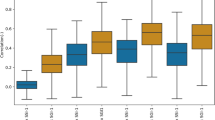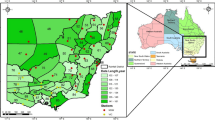Abstract
Hydrological drought early warning systems could greatly improve the efficiency of water resources allocation, particularly in semiarid areas where extensive storage systems are constructed. On the other hand, warning systems that rely on meteorological thresholds (triggers) are relatively easy to use in real-time conditions compared with complicated fully online forecast models. In this study, probabilistic rainfall thresholds triggering the hydrological droughts were determined on monthly basis. The case study region is Urmia Lake basin, holding one of the largest saline lakes in the world that is currently under the drying threat due to prolonged droughts and excessive surface water use. In the first step, the time series of total inflow to the Urmia Lake was transformed to a standardized hydrological drought index. A simple rainfall–drought index model was also developed at basin scale. Then, in an inverse modeling framework, rainfall threshold values causing different hydrological drought severity levels under several occurrence probabilities were determined through repetitive application of rainfall–drought index model. Derived rainfall threshold values were evaluated in a forecast mode against both historical and simulated data using the critical success index. Results revealed that the proposed approach was simple to use and sufficiently accurate in forecast of hydrological droughts, while mean probable threshold curve offered the best performance.










Similar content being viewed by others
References
Changnon SA, Easterling WE (1989) Measuring drought impacts: the Illinois case. Water Resour Bull 25:27–42
Dehghani M, Saghafian B, Farokhnia A, Noori R (2014) Uncertainty analysis of streamflow drought forecast using artificial neural networks and Monte-Carlo simulation. Int J Climatol 34(4):1169–1180. doi:10.1002/joc.3754
Edwards DC, McKee TB (1997) Characteristics of 20th century drought in the United States at multiple time scales. Climatology report number 97-2, Colorado State University, Fort Collins, Colorado
Golian S, Saghafian B, Maknoon R (2010) Derivation of probabilistic thresholds of spatially distributed rainfall for flood forecasting. J Water Resour Manage 24:3547–3559. doi:10.1007/s11269-010-9619-7
Golian S, Saghafian B, Elmi M, Maknoon R (2011) Probabilistic rainfall thresholds for flood forecasting: evaluating different methodologies for modeling rainfall spatial correlation (or dependence). J Hydrol Process 25:2046–2055. doi:10.1002/hyp.7956
Gourley J, Erlingis M, Hong Y, Wells E (2011) Evaluation of tools used for monitoring and forecasting flash floods in the United States. J Weather Forecast 27:158–173
Hayes M, Wilhite DA, Svoboda M, Vanyarkho O (1999) Monitoring the 1996 drought using the standardized precipitation index. Bull Am Meteorol Soc 80:429–438
Hisdal H, Tallaksen LM (eds) (2000) Drought event definition ARIDE Technical report no. 6, University of Oslo, Oslo, Norway
Kjeldsen RT, Lundorf A, Rosbjerg D (2000) Use of a two-component exponential distribution in partial duration modeling of hydrological drought in Zimbabwean rivers. J Hydrol Sci 45(2):285–298
Komuscu AU (1999) Using the SPI to analyze spatial and temporal patterns of drought in Turkey. Drought Netw News 11(1):7–13
Martina MLV, Todini E, Libralon A (2006) A Bayesian decision approach to rainfall thresholds based flood warning. J Hydrol Earth Syst Sci 10:413–426
Mason SJ, Graham NE (1999) Conditional probabilities, relative operating characteristics and relative operating levels. J Weather Forecast 14:713–725
McKee TB, Doesken JN, Kleist J (1993) The relationship of drought frequency and duration to time scales. In: 8th Conference on applied climatology, January 17–22, Anaheim, California, 179–184
McKee TB, Doesken JN, Kleist J (1995) Drought monitoring with multiple time scales. In: 9th Conference on applied climatology, American Meteorological Society, Boston, 233–236
Ministry of Energy (2010) Water resources and consumptions in Urmia Lake basin. Technical report of water and wastewater planning office, Tehran, Iran: Iran Ministry of Energy (in Persian)
Nalbantis I (2008) Evaluation of a hydrological drought index. J Eur Water 23(24):67–77
Nalbantis I, Tsakiris G (2009) Assessment of hydrological drought revisited. J Water Resour Manage 23:881–897
National Weather Service (2008) What is drought? http://www.nws.noaa.gov/os/brochures/climate/DroughtPublic2.pdf
Norbiato D, Borga M, Dinale R (2009) Flash flood warning in ungauged basins by use of the flash flood guidance and model-based runoff thresholds. J Meteorol Appl 16:65–75
Pandey RP, Mishra SK, Singh R, Ramasastri KS (2008) Streamflow drought severity analysis of Betwa River System (India). J Water Resour Manage 22:1127–1141
Piantados J, Boland J, Howlett Ph (2009) Generating synthetic rainfall on various timescales—daily, monthly and yearly. J Environ Model Assess 14:431–438
Ramsar Convention Website. http://ramsar.org
Sene K (2010) Hydrometeorology, forecasting and applications. Springer, Heidelberg
Sharma TC, Panu US (2010) Analytical procedures for weekly hydrological droughts: a case of Canadian rivers. J Hydrol Sci 55(1):79–92
Sivakumar B (2005) Hydrologic modeling and forecasting: role of thresholds. J Environ Modell Softw 20:515–519
Szalai S, Szinell CS, Zoboki J (2000) Drought monitoring in Hungary. In: Wilhite DA, Sivakumar MVK, Wood DA (eds) Early warning systems for drought preparedness and drought management. World Meteorological Organization, Lisboa, pp 182–199
U.S. Army Corps of Engineers (USACE) (1996) Hydrologic aspects of flood warning-preparedness programs. Report ETL 1110-2-540, Office of Chief of Engineers, Washington, DC
Wilks DS, Wilby RL (1999) The weather generation game: a review of stochastic weather models. Prog Phys Geogr 23(3):329–357. doi:10.1177/030913339902300302
Zeng H, Li L, Li J (2012) The evaluation of TRMM multi-satellite precipitation analysis (TMPA) in drought monitoring in the Lancang River Basin. J Geogr Sci 22:273–282
Author information
Authors and Affiliations
Corresponding author
Rights and permissions
About this article
Cite this article
Saghafian, B., Hamzekhani, F.G. Hydrological drought early warning based on rainfall threshold. Nat Hazards 79, 815–832 (2015). https://doi.org/10.1007/s11069-015-1876-6
Received:
Accepted:
Published:
Issue Date:
DOI: https://doi.org/10.1007/s11069-015-1876-6




